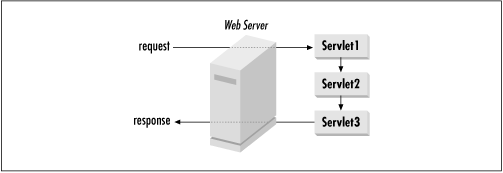Servlet Chaining and Filters
Now you’ve seen how an individual servlet can create content by generating a full page or by being used in a server-side include. Servlets can also cooperate to create content in a process called servlet chaining .
In many servers that support servlets, a request can be handled by a sequence of servlets. The request from the client browser is sent to the first servlet in the chain. The response from the last servlet in the chain is returned to the browser. In between, the output from each servlet is passed (piped) as input to the next servlet, so each servlet in the chain has the option to change or extend the content, as shown in Figure 2.9.[8]
There are two common ways to trigger a chain of servlets for an incoming request. First, you can tell the server that certain URLs should be handled by an explicitly specified chain. Or, you can tell the server to send all output of a particular content type through a specified servlet before it is returned to the client, effectively creating a chain on the fly. When a servlet converts one type of content into another, the technique is called filtering .

Figure 2-9. Servlet chaining
Servlet chaining can change the way you think about web content creation. Here are some of the things you can do with it:
- Quickly change the appearance of a page, a group of pages, or a type of content.
For example, you can improve ...
Get Java Servlet Programming now with the O’Reilly learning platform.
O’Reilly members experience books, live events, courses curated by job role, and more from O’Reilly and nearly 200 top publishers.

